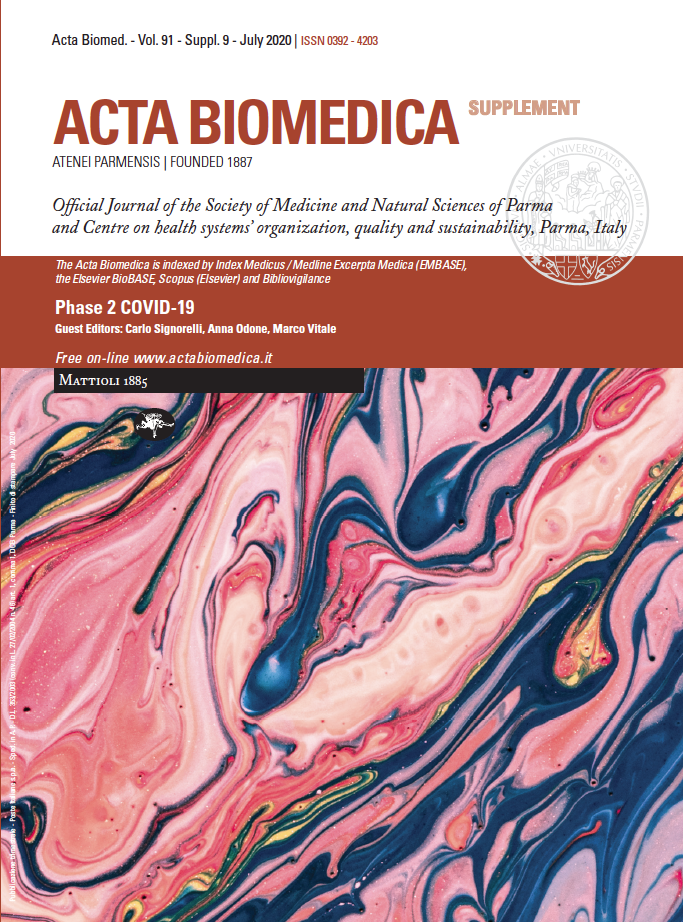Post-COVID-19 follow-up clinic: depicting chronicity of a new disease
Keywords:
COVID-19, SARS-CoV-2, follow-up, biobankingAbstract
Background and aim of the work: The coronavirus disease-19 (COVID-19) outbreak is posing considerable challenges to healthcare systems and societies worldwide. While the knowledge on the acute phase of the disease has rapidly expanded, little is known on the consequences of COVID-19 following clinical remission. We set up a multidisciplinary COVID-19 follow-up outpatient clinic to identify and address the clinical needs of COVID-19 survivors. Here we describe the features of our follow-up programme. Methods: The multidisciplinary assessment comprises a complete physical examination, respiratory evaluation (peripheral oxygen saturation, respiratory rate, dyspnoea assessment, lung ultrasound and pulmonary function), cardiovascular assessment (electrocardiography, echocardiography), nutritional assessment (anthropometrics, mini Nutritional Assessment screening tool), neurological examination including cognitive tests, and mental health assessment. All data are prospectively collected, and blood is sampled for biobanking. Results: Since 7 April to 5 June, 2020, 453 out of the 1388 COVID-19 survivors managed at our University Hospital have been evaluated at the Outpatient COVID-19 Follow-up Clinic. The characteristics of the follow-up cohort are similar to those of the whole cohort of COVID-19 in terms of demographics, comorbidities, and COVID-19 severity upon ED presentation, indicating that the follow-up cohort is representative of the whole cohort. Conclusions: Continuous patient monitoring might give an answer to the numerous unsolved questions about what comes next in this pandemic and beyond. This will help physicians and researchers establish strategies to face future pandemics and develop preventative and therapeutic strategies for similar hyperinflammatory conditions.
References
World Health Organization Quality of Life (WHOQOL) –BREF questionnaire. Available at https://www.who.int/mental_health/media/en/76.pdf?ua=1 Accessed on 22 May 2020.
Wu X, Dong D, Ma D. Thin-Section Computed Tomography Manifestations During Convalescence and Long-Term Follow-Up of Patients with Severe Acute Respiratory Syndrome (SARS). Med Sci Monit 2016;22:2793-9.
Zhou X, Li Y, Li T, Zhang W. Follow-up of asymptomatic patients with SARS-CoV-2 infection. Clin Microbiol Infect 2020.
Ronco C, Reis T, Husain-Syed F. Management of acute kidney injury in patients with COVID-19. Lancet Respir Med 2020.
Ranard LS, Fried JA, Abdalla M et al. Approach to Acute Cardiovascular Complications in COVID-19 Infection. Circ Heart Fail 2020.
Rogers JP, Chesney E, Oliver D et al. Psychiatric and neuropsychiatric presentations associated with severe coronavirus infections: a systematic review and meta-analysis with comparison to the COVID-19 pandemic. Lancet Psychiatry 2020.
Briguglio M, Pregliasco FE, Lombardi G, Perazzo P, Banfi G. The Malnutritional Status of the Host as a Virulence Factor for New Coronavirus SARS-CoV-2. Front Med (Lausanne) 2020;7:146.
Brooks R. EuroQol: the current state of play. Health Policy 1996;37:53-72.
Ross R, Neeland IJ, Yamashita S et al. Waist circumference as a vital sign in clinical practice: a Consensus Statement from the IAS and ICCR Working Group on Visceral Obesity. Nat Rev Endocrinol 2020;16:177-189.
Vellas B, Guigoz Y, Garry PJ et al. The Mini Nutritional Assessment (MNA) and its use in grading the nutritional state of elderly patients. Nutrition 1999;15:116-22.
Carson N, Leach L, Murphy KJ. A re-examination of Montreal Cognitive Assessment (MoCA) cutoff scores. Int J Geriatr Psychiatry 2018;33:379-388.
Levine DW, Dailey ME, Rockhill B, Tipping D, Naughton MJ, Shumaker SA. Validation of the Women's Health Initiative Insomnia Rating Scale in a multicenter controlled clinical trial. Psychosom Med 2005;67:98-104.
Sundin EC, Horowitz MJ. Impact of Event Scale: psychometric properties. Br J Psychiatry 2002;180:205-9.
Tluczek A, Henriques JB, Brown RL. Support for the reliability and validity of a six-item state anxiety scale derived from the State-Trait Anxiety Inventory. J Nurs Meas 2009;17:19-28.
Spagnolo P, Balestro E, Aliberti S et al. Pulmonary fibrosis secondary to COVID-19: a call to arms? Lancet Respir Med 2020.
Mack M. Inflammation and fibrosis. Matrix Biol 2018;68-69:106-121.
Zheng YY, Ma YT, Zhang JY, Xie X. COVID-19 and the cardiovascular system. Nat Rev Cardiol 2020;17:259-260.
Cederholm T, Jensen GL, Correia M et al. GLIM criteria for the diagnosis of malnutrition - A consensus report from the global clinical nutrition community. J Cachexia Sarcopenia Muscle 2019;10:207-217.
Chan KS, Mourtzakis M, Aronson Friedman L et al. Evaluating Muscle Mass in Survivors of Acute Respiratory Distress Syndrome: A 1-Year Multicenter Longitudinal Study. Crit Care Med 2018;46:1238-1246.
Pan L, Mu M, Yang P et al. Clinical Characteristics of COVID-19 Patients With Digestive Symptoms in Hubei, China: A Descriptive, Cross-Sectional, Multicenter Study. Am J Gastroenterol 2020;115:766-773.
Lechien JR, Chiesa-Estomba CM, De Siati DR et al. Olfactory and gustatory dysfunctions as a clinical presentation of mild-to-moderate forms of the coronavirus disease (COVID-19): a multicenter European study. Eur Arch Otorhinolaryngol 2020.
Natoli S, Oliveira V, Calabresi P, Maia LF, Pisani A. Does SARS-Cov-2 invade the brain? Translational lessons from animal models. Eur J Neurol 2020.
Liu N, Zhang F, Wei C et al. Prevalence and predictors of PTSS during COVID-19 outbreak in China hardest-hit areas: Gender differences matter. Psychiatry Res 2020;287:112921.
Downloads
Published
Issue
Section
License
This is an Open Access article distributed under the terms of the Creative Commons Attribution License (https://creativecommons.org/licenses/by-nc/4.0) which permits unrestricted use, distribution, and reproduction in any medium, provided the original work is properly cited.
Transfer of Copyright and Permission to Reproduce Parts of Published Papers.
Authors retain the copyright for their published work. No formal permission will be required to reproduce parts (tables or illustrations) of published papers, provided the source is quoted appropriately and reproduction has no commercial intent. Reproductions with commercial intent will require written permission and payment of royalties.







